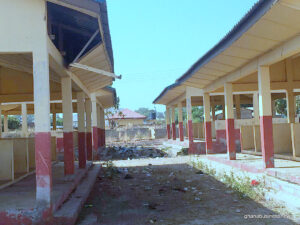AfDB evaluation finds that Fufulso-Sawla road and projects reduce poverty in communities

The African Development Bank (AfDB) loaned Ghana some $156 million from its African Development Fund to construct the Fufulso-Sawla road and additional projects including schools, teachers’ quarters, clinics, lorry parks, markets, and water systems. The project was concluded on scheduled in 38 months and launched in August 2015. The Ghana government raised the counterpart funding of additional $10 million to raise the total to $166 million.
While the 147.5km road and projects have not seen any maintenance since inauguration, and are deteriorating, an evaluation of the project by the AfDB has found that the project has achieved its expected outcomes.
The evaluation found that the project has reduced poverty and increased monthly household income in the beneficiary communities.
“The evaluation focused in particular on several indicators to determine the impact of the road on poverty and economic development, revealing that the project had produced the expected effects: reduction of 2.16 per cent in the multidimensional poverty index among beneficiary households in 2015, increase in monthly household income of about $68,” it said.
Two Chinese contractors were awarded the projects. According to the Bank’s evaluation report, at completion, the 147.5km of road built between Sawla and Fufulso was divided into two sections, Lot 1 (Fufulso-Larabanga) and Lot 2 (Larabanga-Sawla). Each Lot also incorporated several ancillary works serving 15 communities along the entire corridor. The construction in Lot 1 was carried out by the China International Water & Electric Corporation. The company took charge and executed all road and ancillary works. The China Harbour Engineering Company Ltd was the construction contractor in Lot 2; the company subcontracted the ancillary works to a third party.
The same consultant supervised the work in both lots. The constructors’ contract included a
12 months defects liability period (DPL). The road constructed was a Double Bituminous Surface Treatment (DBST), standard of a 7.3m two-way one lane single carriageway plus 2.5m
shoulders on each side of the carriageway. The ancillary works built in the 15 communities located
along the corridor varied across communities. They encompassed school facilities, health centers, and rehabilitation/renovation of the hospital in Damongo, accommodations for nurses and teachers, Kumasi Ventilated Improved Pits (KVIPs), boreholes, truck parks, markets, and a grain storage facility.
Proportionally, 36 percent of the ancillary work was allocated to health facilities, 28 percent to
education facilities, 2 per cent to the grain store built in Damongo, 9 per cent to water supplies (boreholes), and 25 per cent to markets and truck parks, the report noted.
The report indicated further that the project enabled communities and households in northern Ghana to benefit from improved infrastructure, increased local economic activity and better access to health and education.
“In detail, we note a 33 per cent reduction in the average commuting time, an improvement in conditions (+14 per cent), integration (+7 per cent) and diversification (+2.2 per cent) markets as well as a 17 per cent increase in the water quality index and a 14 per cent improvement in the sanitary conditions index among beneficiary households in 2019. Women and girls benefited greatly from the project in health and education,” it added.
The evaluators however, found, following exchanges with the beneficiaries, that the lack of maintenance affected a large number of the facilities provided (health centres, schools, housing built for teachers and nurses, treatment station waters) ; part of the road has also deteriorated. The project has affected the environment due to a significant increase in charcoal burning in the three beneficiary districts.
By Emmanuel K. Dogbevi
Copyright ©2022 by NewsBridge Africa
All rights reserved. This article or any portion thereof may not be reproduced or used in any manner whatsoever without the express written permission of the publisher except for the use of brief quotations in reviews.
